Chapter 1. BIOLOGY: HOW LIFE WORKS
BIOLOGY: HOW LIFE WORKS
1
James Morris
BRANDEIS UNIVERSITY
Daniel Hartl
HARVARD UNIVERSITY
Andrew Knoll
HARVARD UNIVERSITY
Robert Lue
HARVARD UNIVERSITY
ANDREW BERRY, ANDREW BIEWENER, BRIAN FARRELL, N. MICHELE HOLBROOK, NAOMI PIERCE, ALAIN VIEL
HARVARD UNIVERSITY

W.H. Freeman and Company
A Macmillan Higher Education Company
2
PUBLISHER Susan Winslow
LEAD DEVELOPMENTAL EDITOR Lisa Samols
SENIOR DEVELOPMENTAL EDITOR Susan Moran
DEVELOPMENTAL EDITOR Erica Pantages Frost
EDITORIAL ASSISTANTS Yassamine Ebadat, Jane Taylor
REVIEW COORDINATOR Donna Brodman
PROJECT MANAGER Karen Misler
ART MANAGER Carolyn Deacy
EDITORIAL RESEARCH AND DEVELOPMENT Shannon Howard
MARKET DEVELOPMENT MANAGER Lindsey Veautour
ASSOCIATE DIRECTOR OF MARKETING Debbie Clare
LEAD ASSESSMENT AUTHOR Melissa Michael
ASSESSMENT AUTHORS/TEAM LEADERS Mark Hens, John Merrill, Randall Phillis, Debra Pires
ART AND MEDIA DIRECTOR Robert Lue, Harvard University
MANAGER OF DIGITAL DEVELOPMENT Amanda Dunning
SENIOR DEVELOPMENT EDITOR FOR TEACHING & LEARNING STRATEGIES Elaine Palucki
SENIOR MEDIA PRODUCER Keri Fowler
PROJECT EDITOR Robert Errera
MANUSCRIPT EDITOR Nancy Brooks
DESIGN MGMT. design
SENIOR ILLUSTRATION COORDINATOR Bill Page
ILLUSTRATIONS Imagineering
CREATIVE DIRECTOR Mark Mykytiuk, Imagineering
ART DIRECTOR Diana Blume
LAYOUT ARTIST Tom Carling, Carling Design Inc.
PHOTO EDITOR Christine Buese
PHOTO RESEARCHERS Jacquelin Wong and Deborah Anderson
PRODUCTION MANAGER Paul Rohloff
COMPOSITION MPS Limited
PRINTING AND BINDING Quad Graphics-Versailles
Library of Congress Control Number: 2012948406
ISBN-13: 978-1-4292-1870-2
ISBN-10: 1-4292-1870-3
International Edition
ISBN-13: 978-1-4641-5601-4
ISBN-10: 1-4641-5601-8
© 2013 by W. H. Freeman and Company. All rights Reserved.
Printed in the united states of America
Third printing
Macmillan
W. H. Freeman and Company
41 Madison Avenue
New York, NY 10010
Houndmills, Basingstoke RG21 6XS, England
www.macmillanhighereducation.com/international
www.whfreeman.com
3
To all who are curious about life and how it works.
4
ABOUT THE AUTHORS
James R. Morris is Associate Professor in the Biology Department at Brandeis University. He teaches introductory biology, as well as a wide variety of courses for majors and non-majors in evolution, genetics, genomics, and anatomy. In addition, he teaches a first-year seminar focusing on Darwin’s On the Origin of Species. He is the recipient of numerous teaching awards. His research focuses on the rapidly growing field of epigenetics, using the fruit fly Drosophila melanogaster as a model organism. He currently pursues this research with undergraduates in order to give them the opportunity to do genuine, laboratory-based research early in their scientific careers. Dr. Morris received a PhD in genetics from Harvard University and an MD from Harvard Medical School. He was a Junior Fellow in the Society of Fellows at Harvard University, has given talks to the public on current science at the Museum of Science in Boston, and works on promoting public understanding of personal genetics and genomics.
Daniel L. Hartl is Higgins Professor of Biology in the Department of Organismic and Evolutionary Biology at Harvard university. He has taught highly popular courses in genetics and evolution at both the introductory and advanced levels. His lab studies molecular evolutionary genetics and population genetics and genomics. Dr. Hartl is the recipient of the Samuel Weiner Outstanding Scholar Award and the Medal of the Stazione Zoologica Anton Dohrn, Naples. He is a member of the National Academy of Sciences and the American Academy of Arts and Sciences. He has served as President of the Genetics Society of America and President of the Society for Molecular Biology and Evolution. Dr. Hartl’s PhD was awarded by the University of Wisconsin, and he did postdoctoral studies at the university of California, Berkeley. Before joining the Harvard faculty, he served on the faculties of the University of Minnesota, Purdue University, and Washington University Medical School. In addition to publishing more than 350 scientific articles, Dr. Hartl has authored or coauthored 30 books.
Andrew H. Knoll is Fisher Professor of Natural History in the Department of Organismic and Evolutionary Biology at Harvard University. He is also Professor of Earth and Planetary Sciences. Dr. Knoll teaches introductory courses in both departments. His research focuses on the early evolution of life, Precambrian environmental history, and the interconnections between the two. He has also worked extensively on the early evolution of animals, mass extinction, and plant evolution. He currently serves on the science team for NASA’s mission to Mars. Dr. Knoll received the Phi Beta Kappa Book Award in Science for Life on a Young Planet. Other honors include the Paleontological Society Medal and Wollaston Medal of the Geological Society, London. He is a member of the National Academy of Sciences, the American Academy of Arts and Sciences, and the American Philosophical Society. He received his PhD from Harvard University and then taught at Oberlin College before returning to Harvard.
Robert A. Lue is Professor in the Department of Molecular and Cellular Biology and Director of Life Science Education at Harvard University. He regularly teaches courses in Harvard’s first-year Life Sciences program and upper-level courses in cell biology. He has a long-standing commitment to interdisciplinary teaching and research, and chaired the faculty committee that developed an integrated science course to serve science majors and premedical students. Dr. Lue has also developed award-winning multimedia, including the animation “The Inner Life of the Cell.” He has coauthored undergraduate biology textbooks and chaired education conferences on college biology for the National Academies and the National Science Foundation and on diversity in science for the Howard Hughes Medical Institute and the National Institutes of Health. He also founded and directs a Harvard Life Sciences outreach program that serves over 50 high schools. He received his PhD from Harvard University.
Andrew Berry is Lecturer in the Department of Organismic and Evolutionary Biology and an undergraduate advisor in the Life Sciences at Harvard University. He teaches courses in Harvard’s first-year Life Sciences program, as well as courses on evolution and Darwin. His research interests are in evolutionary biology and the history of science. He has coauthored two books: Infinite Tropics, a collection of the writings of Alfred Russel Wallace, and DNA: The Secret of Life, which is part history, part exploration of the controversies swirling around DNA-based technology.
Andrew A. Biewener is Charles P. Lyman Professor of Biology in the Department of organismic and Evolutionary Biology at Harvard University and Director of the Concord Field Station. He teaches both introductory and advanced courses in anatomy, physiology, and biomechanics. His research focuses on the comparative biomechanics and neuromuscular control of mammalian and avian locomotion, with relevance to biorobotics. He is currently Deputy Editor-in-Chief for the Journal of Experimental Biology. He also served as President of the American Society of Biomechanics.
5
Brian D. Farrell is Professor of Biology in the Department of Organismic and Evolutionary Biology at Harvard University and Curator of Entomology in the Museum of Comparative Zoology. He has collaborated with Los Niños de Leonardo y Meredith in the Dominican Republic to teach children about native insects, and participates in an All Taxa Biodiversity Inventory of the Boston Harbor Islands National Recreation Area. His research focuses on the interplay of adaptation and historical contingency in species diversification, particularly of beetles. In 2011-2012, Dr. Farrell was a Fulbright Scholar to the Universidad Autonoma de Santo Domingo.
N. Michele Holbrook is Charles Bullard Professor of Forestry in the Department of organismic and Evolutionary Biology at Harvard University. She teaches an introductory course on biodiversity as well as advanced courses in plant biology. She studies the physics and physiology of vascular transport in plants with the goal of understanding how constraints on the movement of water and solutes between soil and leaves influences ecological and evolutionary processes.
Naomi E. Pierce is Hessel Professor of Biology in the Department of organismic and Evolutionary Biology at Harvard University and Curator of Lepidoptera in the Museum of Comparative Zoology. She studies and teaches animal behavior and behavioral ecology. Her lab focuses on the ecology of species interactions, such as insect-host plant associations, and on the life-history evolution and systematics of Lepidoptera. She has also been involved in reconstructing the evolutionary tree of life of insects such as ants, bees, and butterflies.
Alain Viel is Director of Undergraduate Research and Senior Lecturer in the Department of Molecular and Cellular Biology at Harvard University. He teaches research-based courses as well as courses in molecular biology and biochemistry. He is a founding member of BioVisions, a collaboration between scientists, teaching faculty, students, and multimedia professionals that focuses on science visualization. Dr. Viel worked with his colleague and Biology: How Life Works coauthor Robert Lue on the animation “The Inner Life of the Cell.”
Biology: How Life Works Assessment Authors
Melissa Michael, Lead Assessment Author, is Director for Core Curriculum and Assistant Director for Undergraduate Instruction for the School of Molecular and Cellular Biology at the University of Illinois at Urbana-Champaign. A cell biologist, she primarily focuses on the continuing development of the School’s undergraduate curricula. She is currently engaged in several projects aimed at improving instruction and assessment at the course and program levels. She continues to work in several different arenas to improve undergraduate biology education.
Mark Hens is Associate Professor of Biology at the University of North Carolina at Greensboro. He has taught introductory biology at this institution since 1996. He is the director of his department’s Introductory Biology Program and is chair of the university’s General Education Council. In these administrative capacities, he leads efforts on his campus to establish learning objectives and develop assessment tools. Dr. Hens is a National Academies Education Mentor at the National Academies/HHMI Summer Institute for Undergraduate Education in Biology. He also serves on the advisory board of an NSF-funded project focused on the assessment of student learning in college science curricula.
John Merrill is Director of the Biological Sciences Program in the College of Natural Science at Michigan State University. This program administers the core biology course sequence required for all science majors. In recent years, Dr. Merrill has focused his research on teaching and learning. With the support of several NSF grants, he is exploring innovative classroom interventions coupled to enhanced assessment. A particularly active area is the use of computers to analyze student’s written responses to conceptual assessment questions, with the goal of making it easier to use open-response questions in large-enrollment classes.
Randall Phillis is Associate Professor of Biology at the University of Massachusetts Amherst. He has taught in the majors introductory biology course at this institution for 19 years and is a National Academies Education Mentor in the Life Sciences. With help from the PEW Center for Academic Transformation (1999), he has been instrumental in transforming the introductory biology course to an active learning format that makes use of classroom communication systems. He also participates in an NSF-funded project to design model-based reasoning assessment tools for use in class and on exams. These tools are being designed to develop and evaluate student scientific reasoning skills, with a focus on topics in introductory biology.
Debra Pires is an Academic Administrator at the University of California, Los Angeles. She teaches the introductory courses in the Life Sciences Core Curriculum. Her research focuses on creating assessment tools to evaluate how well students understand concepts taught in the introductory courses and how well they retain those concepts during their time at UCLA. Student Learning Outcome (SLO)-centered assessments have become a major component of the introductory curriculum, and workshops with faculty in two departments have begun to help instructors develop rubrics and assessment strategies that are aligned with the goals of the long-term study.
6
BRIEF CONTENTS
PART 1 FROM CELLS TO ORGANISMS
CHAPTER 1 LIFE
Chemical, Cellular, and Evolutionary Foundations 1-1
? CASE 1 The First Cell: Life’s Origins C1-1
CHAPTER 2 THE MOLECULES OF LIFE 2-1
CHAPTER 3 NUCLEIC ACIDS AND THE ENCODING OF BIOLOGICAL INFORMATION 3-1
CHAPTER 4 TRANSLATION AND PROTEIN STRUCTURE 4-1
CHAPTER 5 ORGANIZING PRINCIPLES
Lipids, Membranes, and Cell Compartments 5-1
CHAPTER 6 MAKING LIFE WORK
Capturing and Using Energy 6-1
CHAPTER 7 CELLULAR RESPIRATION
Harvesting Energy from Carbohydrates and Other Fuel Molecules 7-1
CHAPTER 8 PHOTOSYNTHESIS
Using Sunlight to Build Carbohydrates 8-1
? CASE 2 Cancer: When Good Cells Go Bad C2-2
CHAPTER 9 CELL COMMUNICATION 9-1
CHAPTER 10 CELL FORM AND FUNCTION
Cytoskeleton, Cellular Junctions, and Extracellular Matrix 10-1
CHAPTER 11 CELL DIVISION
Variations, Regulation, and Cancer 11-1
? CASE 3 You, From A to T: Your Personal Genome C3-2
CHAPTER 12 DNA REPLICATION AND MANIPULATION 12-1
CHAPTER 13 GENOMES 13-1
CHAPTER 14 MUTATION AND DNA REPAIR 14-1
CHAPTER 15 GENETIC VARIATION 15-1
CHAPTER 16 MENDELIAN INHERITANCE 16-1
CHAPTER 17 BEYOND MENDEL
Sex Chromosomes, Linkage, and Organelles 17-1
CHAPTER 18 THE GENETIC AND ENVIRONMENTAL BASIS OF COMPLEX TRAITS 18-1
CHAPTER 19 GENETIC AND EPIGENETIC REGULATION 19-1
CHAPTER 20 GENES AND DEVELOPMENT 20-1
? CASE 4 Malaria: Co-Evolution of Humans and a Parasite C4-2
CHAPTER 21 EVOLUTION
How Genotypes and Phenotypes Change over Time 21-1
CHAPTER 22 SPECIES AND SPECIATION 22-1
CHAPTER 23 EVOLUTIONARY PATTERNS
Phylogeny and Fossils 23-1
CHAPTER 24 HUMAN ORIGINS AND EVOLUTION 24-1
7
PART 2 FROM ORGANISMS TO THE ENVIRONMENT
CHAPTER 25 CYCLING CARBON 25-1
? CASE 5 The Human Microbiome: Diversity Within C5-1
CHAPTER 26 BACTERIA AND ARCHAEA 26-1
CHAPTER 27 EUKARYOTIC CELLS
Origins and Diversity 27-1
CHAPTER 28 BEING MULTICELLULAR 28-1
? CASE 6 Agriculture: Feeding a Growing Population C6-2
CHAPTER 29 PLANT STRUCTURE AND FUNCTION
Moving Photosynthesis onto Land 29-1
CHAPTER 30 PLANT REPRODUCTION
Finding Mates and Dispersing Young 30-1
CHAPTER 31 PLANT GROWTH AND DEVELOPMENT
Building the Plant Body 31-1
CHAPTER 32 PLANT DEFENSE
Keeping the World Green 32-1
CHAPTER 33 PLANT DIVERSITY 33-1
CHAPTER 34 FUNGI
Structure, Function, and Diversity 34-1
? CASE 7 Predator-Prey: A Game of Life and Death C7-1
CHAPTER 35 ANIMAL NERVOUS SYSTEMS 35-1
CHAPTER 36 ANIMAL SENSORY SYSTEMS AND BRAIN FUNCTION 36-1
CHAPTER 37 ANIMAL MOVEMENT
Muscles and Skeletons 37-1
CHAPTER 38 ANIMAL ENDOCRINE SYSTEMS 38-1
CHAPTER 39 ANIMAL CARDIOVASCULAR AND RESPIRATORY SYSTEMS 39-1
CHAPTER 40 ANIMAL METABOLISM, NUTRITION, AND DIGESTION 40-1
CHAPTER 41 ANIMAL RENAL SYSTEMS
Water and Waste 41-1
CHAPTER 42 ANIMAL REPRODUCTION AND DEVELOPMENT 42-1
CHAPTER 43 ANIMAL IMMUNE SYSTEMS 43-1
? CASE 8 Biodiversity Hotspots: Rain Forests and Coral Reefs C8-1
CHAPTER 44 ANIMAL DIVERSITY 44-1
CHAPTER 45 ANIMAL BEHAVIOR 45-1
CHAPTER 46 POPULATION ECOLOGY 46-1
CHAPTER 47 SPECIES INTERACTIONS, COMMUNITIES, AND ECOSYSTEMS 47-1
CHAPTER 48 THE ANTHROPOCENE
Humans as a Planetary Force 48-1
QUICK CHECK ANSWERS Q-1
GLOSSARY G-1
CREDITS/SOURCES CS-1
INDEX I-1
8
VISION AND STORY OF
Dear Students and Instructors,
We wrote this book in recognition of recent and exciting changes in biology, education, and technology. There was a time when introductory biology could cover all of biology over the course of a single year. This is no longer possible. The amount of scientifi c information has grown exponentially, necessitating that we, as teachers, rethink the role of introductory biology and the resources that support it. One goal remains paramount: to help students think like biologists. To think like a biologist means understanding key concepts that span all of biology. It means being able to communicate in the shared language of biologists. It means recognizing the powerful ability of evolution to explain both the unity and diversity of life. It means thinking about how biological research can help solve some of the world’s most pressing issues, from cancer to infectious diseases to biodiversity loss to climate change.
We have also noticed a change in the way biological problems are approached. We now have a “parts list” of genes and proteins for how life works, and many scientists today are focused on how the parts work together. As a result, we can no longer divide information into discrete topics. To prepare students for science as it is currently practiced, we must integrate concepts from different areas of biology as well as from other scientifi c disciplines.
What is particularly exciting for us as teachers is that the remarkable changes in the science of biology are paralleled by a new appreciation for and understanding of how students learn. There is now good evidence that teaching students only by lecturing does not lead to mastery of core concepts. Lecturing alone does not help develop the scientifi c skills and habits of mind that students need to become successful scientists and health-care workers or thoughtful, scientifi cally informed citizens. Students learn most effectively when they are actively involved in their learning and construct their own knowledge through a combination of lectures, problem solving, hands-on experiences, and collaborative work.
At the same time, technology is transforming how and where students access information. The Internet provides all kinds of information at a click. There is no need for a modern textbook to be a reference book. What, then, is the role of a textbook? A textbook needs to be selective, help students see connections between seemingly disparate topics, and make the material engaging and relevant. Technology is also making possible new and unprecedented ways to visualize biological processes and provide interactive ways for students to learn.
To support 21st-century student learning and instructor teaching, we feel that it is time to rethink what takes place both in and out of the introductory biology classroom and to reimagine the resources that can best support these efforts. Biology: How Life Works provides an integrated set of resources to engage students, encourage critical thinking, help students make connections, and provide a framework for further studies.
Sincerely,
The Biology: How Life Works author team
9
BIOLOGY: HOW LIFE WORKS
Rethinking Biology
For the Biology: How Life Works team, it has been an exciting experience to reimagine what a resource for today’s students should look like. We began with the question, “What do we want students to understand and apply at the end of the course?” Once we decided where we wanted students to end up, we started asking other questions: What content should be covered? How should it be organized? How should it be delivered—in the narrative, a figure, an animation? What questions should we ask students to gauge their understanding? What questions should we ask to help students work toward that understanding? Through this process of questioning and answering, one point became clear—we’d have to start from scratch and build Biology: How Life Works from the ground up.
Rethinking biology means rethinking the text, visual program, and assessment.
Rethinking biology required rethinking the way a textbook is created. Ordinarily, textbooks are developed by first writing chapters, then making decisions about art and images, and finally, once the book is complete, assembling a test bank and ancillary media. This process dramatically limits integration across resources and reduces art, media, and assessments to supplements rather than essential resources for student learning.
Biology: How Life Works is the first project to develop three pillars of learning—the text, visual program, and assessment—at the same time. These three pillars are all tied to the same set of core concepts, share a common language, and use the same visual palette. In this way, the visual program and assessments are integral parts of student learning, rather than accessories to the text. In addition, every concept is conveyed and explored in multiple ways, allowing for authentic learning.
10
Rethinking biology means rethinking: THE TEXT
Biology: How Life Works includes a text that is uniquely integrated, selective, and thematic.
I think the best selling point is that the text focuses on helping students make connections between the subfields of biology.
CINDEE GIFFEN, INSTRUCTOR
UNIVERSITY OF WISCONSIN, MADISON
INTEGRATED
Textbooks commonly present biology as a series of minimally related chapters. This style of presentation lends itself to memorization and offers students little guidance on how concepts connect to one another and to the bigger picture. Biology: How Life Works moves away from this model and toward an integrated approach. Across the book, we present chemistry in context, and cover structure and function together. We introduce the flow of information in a cell where it makes the most conceptual sense and use cases as a framework for connecting and assimilating information.
I like its simplicity and focus on key concepts using relevant examples. Linkage to previous chapters was one of the strongest parts.
DAVID HICKS, INSTRUCTOR
THE UNIVERSITY OF TEXAS AT BROWNSVILLE
SELECTIVE
With the ever-increasing scope of biology, it is unrealistic to expect the majors course or a textbook to cover everything. From the start, we envisioned Biology: How Life Works not as a reference book for all of biology, but as a resource focused on foundational concepts, terms, and experiments. We explain fundamental topics carefully, with an appropriate amount of supporting detail. This allows students to more easily identify, understand, and apply critical concepts. In this way, students will leave an introductory biology class with a framework on which to build.
I really like the streamlined approach and emphasis on ideas and concepts rather than details and facts.
SCOTT SOLOMON, INSTRUCTOR
RICE UNIVERSITY
THEMATIC
We wrote Biology: How Life Works with six themes in mind. Deciding on these themes in advance helped us make decisions about which concepts to include and how to organize them. Introduced in Chapter 1 and revisited throughout the text, the themes provide a framework that helps students see biology as a set of connected concepts. In particular, we emphasize the theme of evolution for its ability to explain and predict so many patterns in biology.
I like the evolution emphasis throughout. If evolution really is the central organizing principle in biology, it’s about time somebody wrote an introductory textbook that reflects that.
DAVID LAMPE, INSTRUCTOR
DUQUESNE UNIVERSITY
- We learn how life works by applying the scientific method, which involves making observations, generating hypotheses, and testing hypotheses through experiment and observation.
- Life works according to fundamental principles of chemistry and physics. All organisms share a limited number of molecules and chemical processes.
- All of the chemical and physical functions of life are packaged within cells. Multicellular organisms function by the differentiation and coordinated operation of many cells.
- Both the features that organisms share and those that set them apart are explained by evolution. Variation exists within as well as between species.
- Organisms interact in nature, with basic features of anatomy, physiology, and behavior shaping the ecological systems that sustain life.
- Humans have emerged as major agents in ecology and evolution. Our future welfare depends, in part, on improving our knowledge of how life works.
I think it is more readable than the text we currently use and it does a better job of integrating the theme of evolution.
KATHRYN CRAVEN, INSTRUCTOR
ARMSTRONG ATLANTIC UNIVERSITY
11
Rethinking biology means rethinking: THE VISUAL PROGRAM
The Biology: How Life Works visual program—all art and visual media—is an integrated, engaging, visual framework for understanding and connecting concepts.
I think the figures are much simpler for beginning students to understand. I found all of the figures in my chapter to be clear, concise, and distilled into the most relevant facts necessary to illustrate the concepts.
DALE CASAMATTA, INSTRUCTOR
UNIVERSITY OF NORTH FLORIDA
INTEGRATED
Just as we decided on a consistent vocabulary to explain concepts and processes, we also created a consistent “visual language.” This means that across Biology: How Life Works—whether students are looking at a figure in the book, watching an animation, or interacting with a simulation—they see a consistent use of color, shapes, and design. Having a coherent, integrated visual program allows students to recognize concepts they have already encountered, and assimilate new information.
The figures in this chapter [Chapter 22: Species and Speciation] are particularly good. These are not the only great figures, but they are among my favorites for how they demonstrate a concept so easily that might otherwise require a couple of paragraphs of text.
MATT BREWER, INSTRUCTOR
GEORGIA STATE UNIVERSITY
ENGAGING
We have a shared goal with instructors—we want students to want to learn more. Cognitive science tells us visualization is tremendously effective at triggering student interest and passion. With that in mind, the Biology: How Life Works team committed to designing and developing a visual program with the same attention and care that goes into text development. Every image—still and in motion—engages students by being vibrant, clear, and approachable. The result is a visual environment that pulls students in, deepens their interest, and helps them see a world of biological processes.
My initial reaction was “Wow.” It [animation on gene expression] helped me visualise the spatial relationships associated with information flow at the cellular level, and I think it is thus likely to really help undergraduates.
DAVE KUBIEN, INSTRUCTOR
UNIVERSITY OF NEW BRUNSWICK
VISUAL FRAMEWORK

Scientists often build a contextual picture, or visual framework, in their mind upon which they hang facts and connect ideas. To help students think like biologists, our visual program deliberately provides this type of framework. Individual figures present foundational concepts; Visual Synthesis figures tie together multiple concepts across multiple chapters; animations bring these figures to life, allowing students to explore concepts in space and time; and simulations have students interact with the concepts. Collectively, this visual framework gives students a way to contextualize information—to move seamlessly back and forth between the big picture and the details, from the basic to the complex.
12
Rethinking biology means rethinking: ASSESSMENT
Biology: How Life Works represents a groundbreaking departure from traditional assessment materials. Written by leaders in science education in collaboration with the authors, our assessments are fully integrated with the text and visual program, span the full range of Bloom’s Taxonomy, and are properly aligned.
The pre-class questions are basic and yet not simple repeat-from-reading, and the other questions fit comfortably at the level where I think they’ll challenge my students but not be so difficult they’re unreachable for them. I particularly like that many of these questions involve interpreting data, or analyzing a case story.
ANNE CASPER EASTERN MICHIGAN UNIVERSITY
INTEGRATED
If assessment is important, it cannot be ancillary—it must be integral to the learning process. Each time an instructor asks a student to engage with Biology: How Life Works—whether it is reading a chapter, watching an animation, or working through an experiment—the opportunity to assess that experience exists. This unprecedented level of integration results from developing assessments alongside the text and visual program. This parallel development also allows for consistency of language and focus, helping students connect what they have read with the questions they are being asked to answer.
These questions are great in that they really require a greater depth of understanding and ability to apply concepts than I’ve seen in any other assessment packages. There’s a clear connection between the pedagogical approach of the textbook and the assessment materials.
SONJA PYOTT, INSTRUCTOR
UNIVERSITY OF NORTH CAROLINA AT WILMINGTON
RANGE
For the first time, instructors in majors biology have access to a set of thoughtfully developed, peer-reviewed formative and summative assessments. Most test banks consist entirely of low-order, recall questions. Consequently, instructors wanting to teach and test at a range of levels are left with the time-consuming task of creating their own higher-order questions. The Biology: How Life Works assessment team has done the “heavy lifting” of question writing for instructors—providing assessments that span everything from recall to synthesis. They are designed to be used in a range of settings (pre-class, in-class, post-class, and exam) and come in a variety of formats (multiple choice, multiple true/false, free response). In addition to questions, our assessments include in-class activities and interactive, online exercises.
The questions in these assessments seem to be superior, since they require higher-order thinking and application of knowledge, rather than just simple factual recall.
PEGGY ROLFSEN, INSTRUCTOR
CINCINNATI STATE TECHNICAL AND COMMUNITY COLLEGE
ALIGNED
Traditionally, assessment questions are provided as test banks, organized by chapter but not as a series designed to work together. We believe questions aren’t just for testing—they are for teaching. To help instructors assess students in more meaningful ways, we wrote and organized sets of questions we call progressions. Progressions include formative and summative assessment—reading comprehension questions, in-class activities, post-class assignments, and exam questions—all properly aligned with the text’s core concepts. Used in sequence, questions within a progression provide a connected learning path for students and a suggested teaching path for instructors.
There are more suggestions about how to use various types of assessments—my current text gives examples of questions but it is left to me to imagine how I might use them.
LISA ELFRING UNIVERSITY OF ARIZONA
13
AUTHORING BIOLOGY: HOW LIFE WORKS
Biology: How Life Works is authored by a team of nationally recognized scientists and educators.
James Morris, Lead Author, Brandeis University
Daniel Hartl, Lead Author, Harvard University
Andrew Knoll, Lead Author, Harvard University
Robert Lue, Lead Author and Visual Program Director, Harvard University
Andrew Berry, Author, Harvard University
Andrew Biewener, Author, Harvard University
Brian Farrell, Author, Harvard University
N. Michele Holbrook, Author, Harvard University
Naomi Pierce, Author, Harvard University
Alain Viel, Author, Harvard University
I think it’s time for an innovative approach to a biology text for majors. Your team of authors has the ideal combination of research and teaching experience to be successful in developing a superior text that reflects the contemporary biological sciences.
ERIK SKULLY
TOWSON UNIVERSITY
Melissa Michael, Lead Assessment Author, University of Illinois at Urbana-Champaign
Mark Hens, Assessment Author, University of North Carolina at Greensboro
John Merrill, Assessment Author, Michigan State University
Randall Phillis, Assessment Author, University of Massachusetts Amherst
Debra Pires, Assessment Author, University of California, Los Angeles
It has a really fresh narrative voice…. It kept the details to a minimum, but presented the information clearly enough that I think students will get the big picture without getting bogged down in the details. Where details were given, they were mostly based on exciting, new findings in the field.
LAURA BERMINGHAM
UNIVERSITY OF VERMONT
The mission of Biology: How Life Works is not to cover all of biology, but to provide a proper introduction. This selective approach requires a large team of educators who are experts in their respective fields. Because the authors possess an intimate knowledge of their fields, they were able to step back and consider where their fields have been, what questions are currently being asked, and where they are heading. It is only with a collective perspective that Biology: How Life Works is able to present contemporary biology in a complete but selective manner.
The multi-author approach was also necessary for the amount of writing, design, development, and collaboration this project required. With the text, visual program, and assessments all being developed in parallel, Biology: How Life Works needed more than one author. Additionally, the level of integration, creativity, and new ideas present in the three pillars of Biology: How Life Works was largely achieved by having a community of authors who were able to dialogue, discuss, and debate.
I’ve reviewed several chapters now, and I like the writing style. It seems more engaging and easy to read, and feels less like reading an encyclopedia than other textbooks do.
MARYJO WITZ
MONROE COMMUNITY COLLEGE
At the same time, Biology: How Life Works has a single voice. This is possible because every chapter, image, animation, and assessment flowed through one author, James Morris. In this way, it benefits from multi-author expertise while telling a single, cohesive story.
In sum, the size of the author team is purposeful and directly supports the goals of the project.
14
KEY FEATURES SUPPORTING THE VISION AND STORY OF BIOLOGY: HOW LIFE WORKS
TOPIC COVERAGE AND ORDER: The goal of a single narrative of biology is supported by the Table of Contents. a select number of important and purposeful changes. Below is an annotated table of
Chapter 1 introduces evolution as a major theme of the book before discussing microevolution in Chapter 4 as a foundation for later discussions of conservation of metabolic pathways and enzyme structure (Chapters 6-8) and genetic and phenotypic variation (Chapters 14 and 15). After the chapters on the mechanisms of evolution (Chapters 21-24), we discuss diversity of all organisms in terms of adaptations and comparative features, culminating in ecology as the ultimate illustration of evolution in action.
The first set of chapters emphasizes three key aspects of a cell—information, homeostasis, and energy. Chemistry is taught in the context of biological processes, highlighting the principle that structure determines function.
I found [Chapter 2: The Molecules of Life] quite readable and it makes the chemistry seem much more relevant to organisms from the beginning.
UDO SAVALLI, INSTRUCTOR
ARIZONA STATE UNIVERSITY WEST
The genetics chapters start with genomes, move to mutation and genetic variation, and then consider inheritance to provide a modern, molecular look at genetic variation and how traits are transmitted.
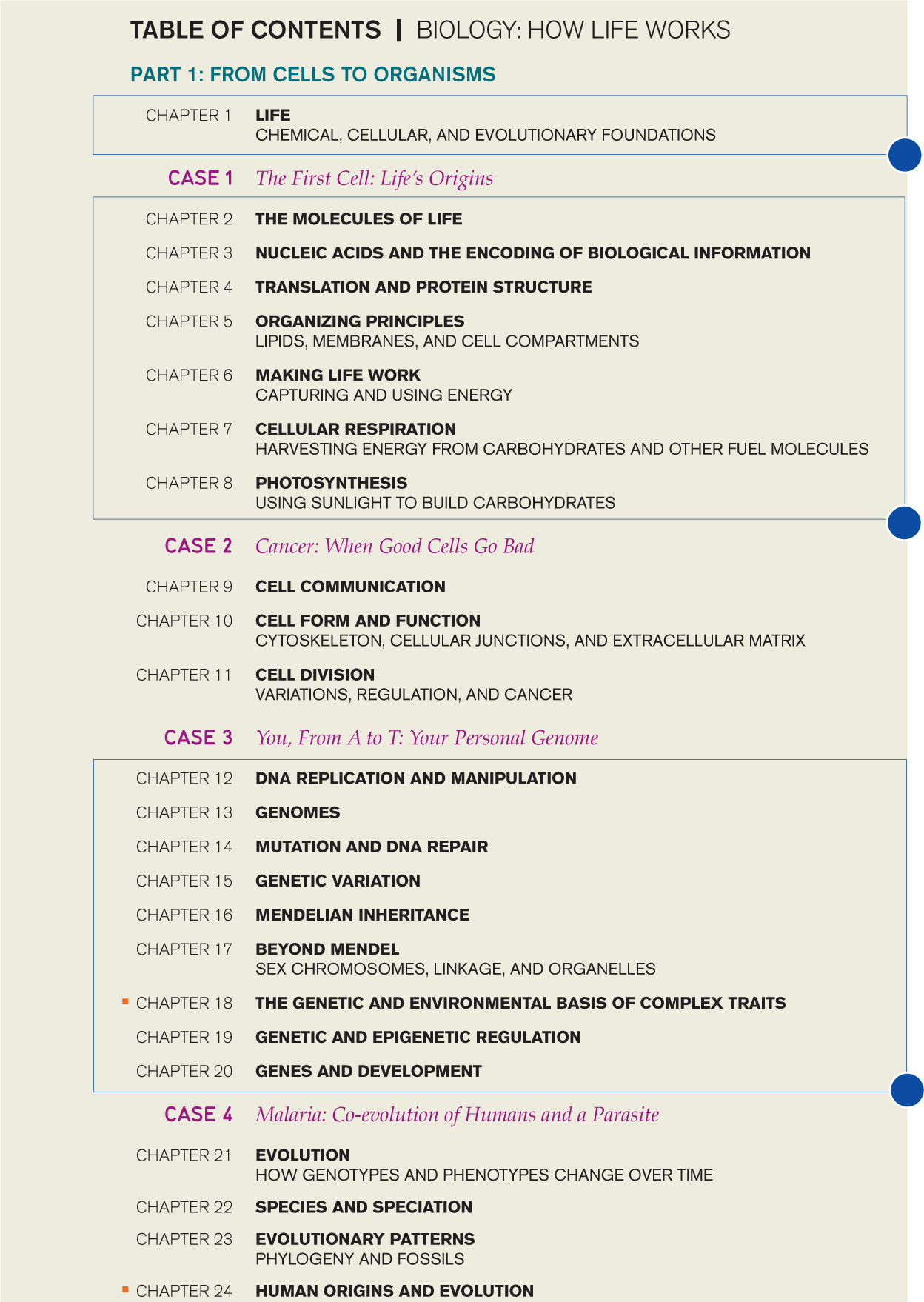
15
KEY FEATURES SUPPORTING THE VISION AND STORY OF BIOLOGY: HOW LIFE WORKS
The book’s chapters and sections are arranged in a familiar way to be used in a range of introductory biology courses, with contents, highlighting these changes and the reasons behind them.
[Chapter 25: Cycling Carbon] does a great job connecting the “halves”; providing examples in the text and asking questions along the way forces the student to give some thought to the topic.…Well done.
STEPHEN TRUMBLE BAYLOR UNIVERSITY
We present the carbon cycle as a bridge between the molecular and organismal parts of the book, integrating ecology and diversity.
The plant chapters combine content in novel ways to better integrate content and provide context for biological processes, such as plant reproduction with the timing of reproductive events.
Diversity follows physiology in order to provide a basis for understanding the groupings of organisms.
- Biology: How Life Works includes chapters that don’t traditionally appear in introductory biology texts, one in almost every major subject area. These novel chapters represent shifts toward a more modern conception of certain topics in biology:
- The basis of complex traits (Chapter 18)
- Human evolution (Chapter 24)
- Cycling carbon (Chapter 25)
- Multicellularity (Chapter 28)
- Plant defenses (Chapter 32)
- Human impact on the environment (Chapter 48)
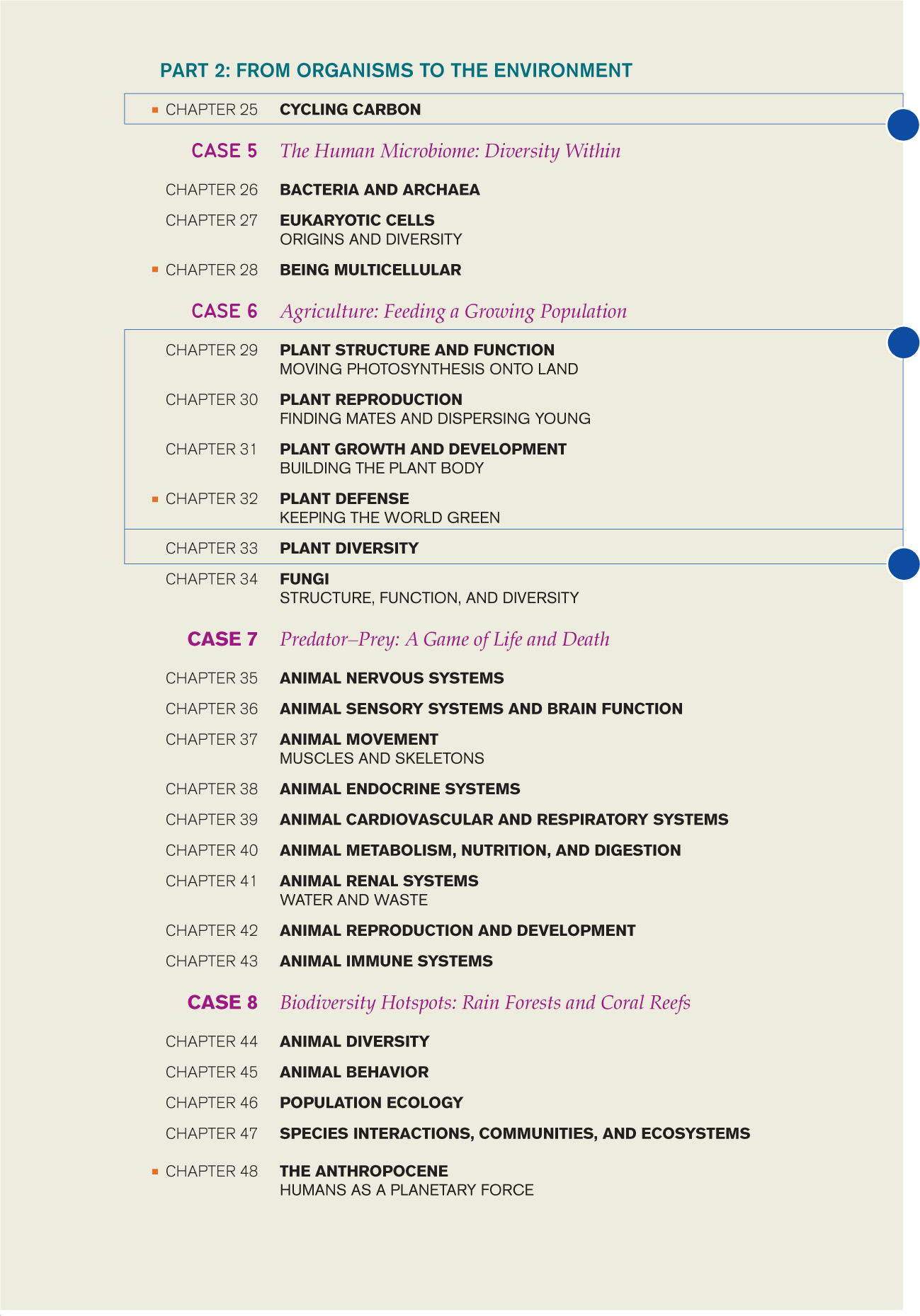
16
CONNECTED LEARNING PATH
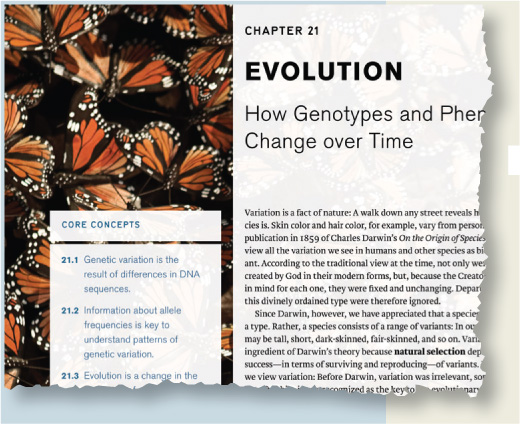
The authors of Biology: How Lile Works rethought the standard pedagogical tools like chapter summaries and end-of-chapter questions. Each element purposefully relates to the same set of core concepts and functions as a connected learning path for students.
Core Concepts listed at the beginning of each chapter map to the chapter’s numbered sections and give students a preview of what ideas they should know by the time they finish reading. We built each chapter around core concepts in order to focus on the most important and overarching ideas in any one topic.
Throughout the chapter, Quick Checks ask students to pause and make sure they’re ready to move on to the next idea. These brief questions pointedly ask the student to demonstrate a full understanding of a tough topic before reading on.

Students revisit the core concepts in the Core Concepts Summary. Here, they can remind themselves of the big-picture ideas from the beginning of the chapter and see them in the context of key supporting ideas.
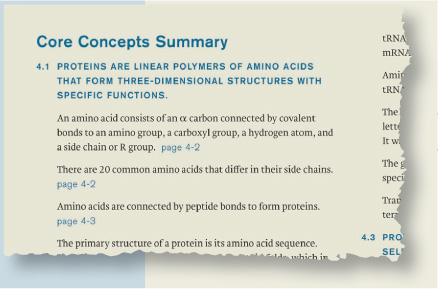
Students test their understanding of core concepts with Self-Assessments. These assessments, along with the online answer guides, allow students to see for themselves whether or not they have understood the major ideas of the chapter.
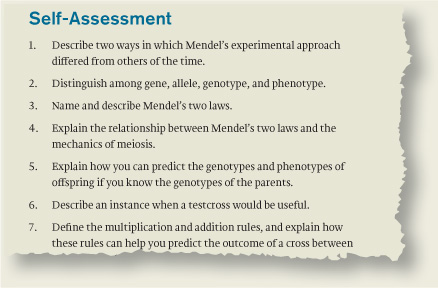
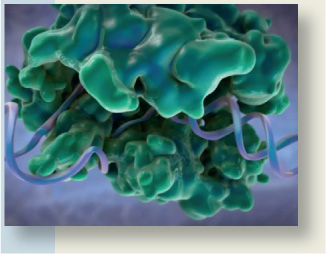
Learning doesn’t end when the printed chapter ends. A wealth of media organized by core concept, including dynamic, zoomable Visual Synthesis figures, animations, and simulations, reinforce what students have read. Assessments give students opportunities to apply what they have learned and hone problem-solving skills.
Instructors can use and assign material from a set of questions we call progressions. Progressions offer questions designed as a sequence to use before, during, and after lecture. Progressions help instructors align the questions they ask on exams to the in-class activities and homework questions they have students engage in before an exam.
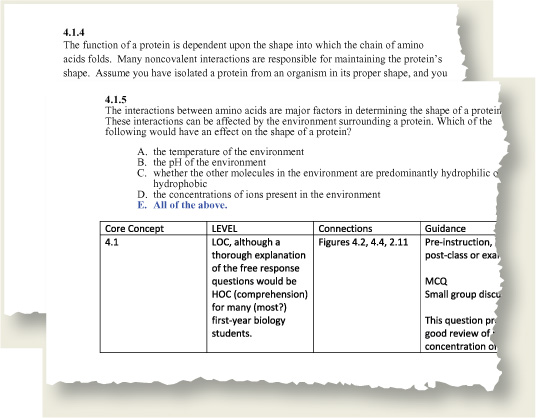
17
VISUAL SYNTHESIS FIGURES
The course I teach strives to integrate concepts across multiple levels of biological complexity and Visual Synthesis would help with this goal.
BRETTON KENT, INSTRUCTOR
UNIVERSITY OF MARYLAND
Visual Synthesis does a great job of summarizing the content of [Chapter 42: Reproduction] in terms of human development. It appears to be very comprehensive including the concepts of fertilization, cleavage (including both maternal and fetal transcription controls) all the way through cell differentiation and tissue development.
CYNTHIA LITTLEJOHN, INSTRUCTOR
UNIVERSITY OF SOUTHERN MISSISSIPPI
The zoomable Visual Synthesis image is an incredibly powerful visual aid for students, allowing instructors to bridge the gap between the details and the larger concept.
ROBERT MAXWELL, INSTRUCTOR
GEORGIA STATE UNIVERSITY
The zoomable digital media is an excellent tool for students and instructors! The interactive capabilities and ability to view content on different levels of complexity are unlike anything I have seen from other texts.
JEANELLE MORGAN, INSTRUCTOR
GAINESVILLE STATE COLLEGE
Just as we integrate topics in biology to create a single narrative, it’s our goal to extend integration to the media by creating a seamless path from the book to all online materials. Visual Synthesis figures represent one way that we integrate the text and media. In the book, a Visual Synthesis figure is a two-page spread and serves as a visual summary integrating concepts across multiple chapters. These figures help students look beyond chapter divisions and see how concepts combine to tell a single story. Students continue their exploration online, where they can interact with a dynamic Visual Synthesis figure. Zooming in and out, students can explore both the big picture and the details, building a framework for how concepts connect and relate. The Visual Synthesis figure also functions as a launch pad to other resources, like animations, simulations, and assessment questions.
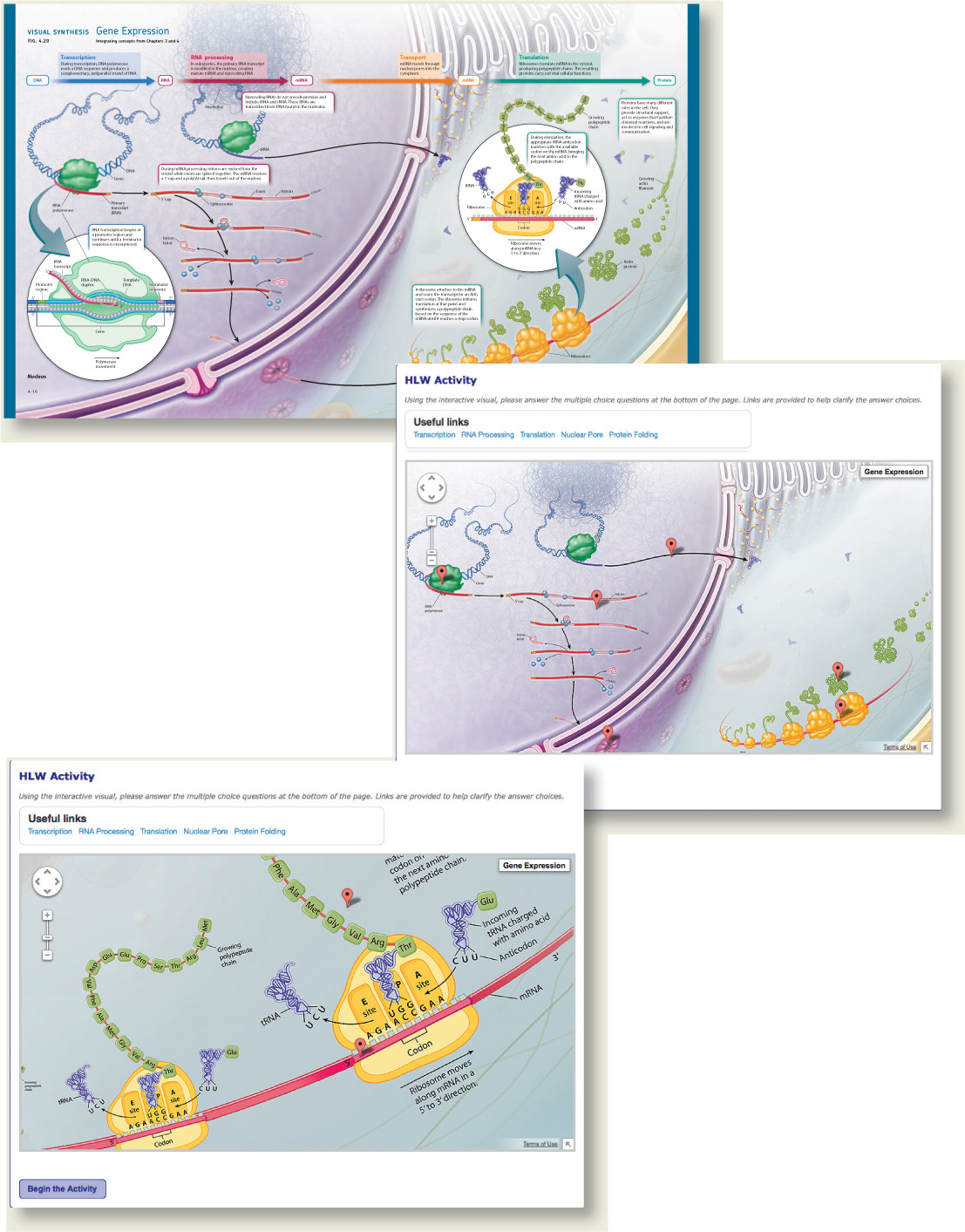
18
ANIMATIONS AND SIMULATIONS
Biological processes are not static—they are dynamic, always in motion. We use animations as an engaging and revealing way to bring biological processes to life, place them in context, and give students an intuitive sense of how these processes work.
I would like to incorporate more animations, virtual labs, and real-life scenarios relating to the concepts we are learning in lecture. It is incredibly helpful when these resources are created by the textbook publisher, so they correspond directly to the material I am covering.
ASHLEY SPRING
BREVARD COMMUNITY COLLEGE
Some concepts are best learned by doing, rather than by reading or watching. Biology: How Life Works simulations allow students to explore biological processes directly and problem solve by doing. Each simulation asks students to work within or break a system, and assessment questions lead students through the system so they can work through a core concept.
Students have trouble visualizing cellular activities, so we constantly look for tools to enhance their understanding.
MARIARET OTT
TYLER JUNIOR COLLEGE
The animations and simulations are available independently but are also integrated into the online, zoomable Visual Synthesis figures. In exploring the Visual Synthesis figure, students can watch animations, answer assessment questions, and interact with simulations to guide them through the illustration.

19
CASES AND CASE ACTIVITIES
Biology is best understood when presented using real and engaging examples as a framework for putting information together. One of the ways we provide this framework is through cases. Each case begins with a two-page essay, providing background and raising questions about the case’s subject. Those questions are answered in subsequent chapters, reinforcing information students have already learned and providing a framework for learning new information. For example, our case about malaria is introduced before the set of chapters on evolution and is revisited in each of these chapters where it serves to reinforce important evolutionary concepts.
The connection of the case study to the two sections in the chapter is a great way to maintain reader engagement and show the connection of material being presented to real-life problems and solutions.
STEPHEN JURIS, INSTRUCTOR
CENTRAL MICHIGAN UNIVERSITY
The Case Activities tie chapter core concepts and cases together, showing students again how what they are learning is relevant to their lives and to a larger picture of biology. We created several activities, varying in length and complexity, for each case. Activities can be assigned as homework or used in class, giving instructors the ability to choose what kind of activity best fits their course needs.
This [Cancer: When Good Cells Go Bad] case study is perfect for this group of chapters because it covers cell division, uncontrolled cell growth, cell communication, genetic control, and transformation. In addition, this topic is relevant to the health of the students taking this course.
SHANNON MCQUAII, INSTRUCTOR
ST. PETERSBURG COLLEGE
I really like this [Cancer: When Good Cells Go Bad] case, including the integration of vaccinations and some public policy questions. This will help students see the real-world application of what they are learning.
JOHN KAUWE, INSTRUCTOR
BRIIHAM YOUNG UNIVERSITY
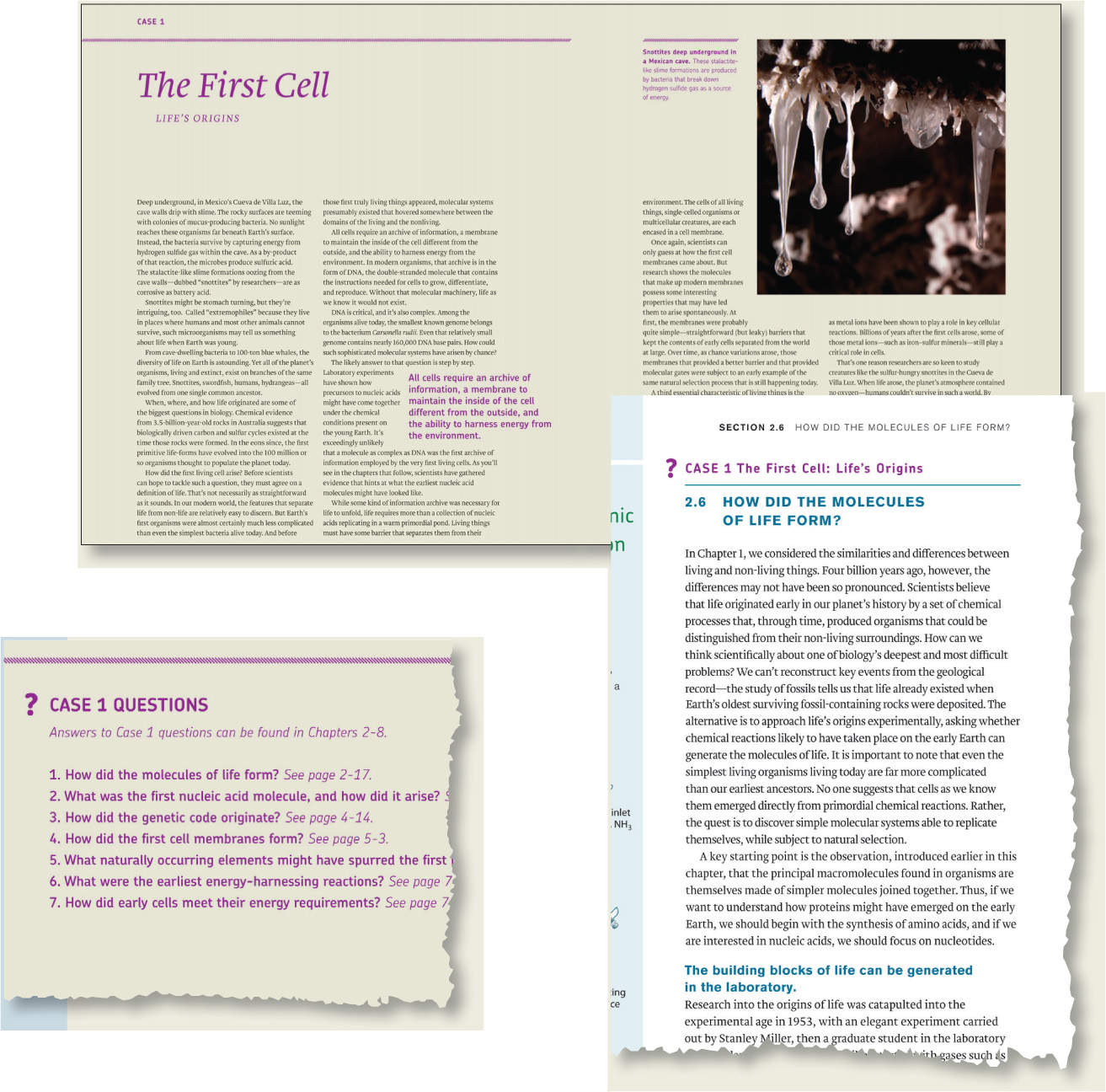
20
HOW DO WE KNOW? FIGURES AND ACTIVITIES
Biology is not just about what we know, but also how we know what we know. An important skill that introductory students must develop is asking questions and forming hypotheses like scientists. Therefore, we introduce key experiments in the narrative flow of the text and then visually unpack the steps of scientific inquiry in How Do We Know? figures. These figures emphasize that science is a process of asking and answering questions and convey an authentic sense of scientific inquiry.
I liked the way that experiments were shown in How Life Works, particularly Fig 8.7 summarized three experiments in a way that students could understand them.
DAVID BYRES
FLORIDA STATE COLLEGE JACKSONVILLE
The exploration of How Do We Know? continues with online activities that emphasize using the scientific method. A How Do We Know? activity begins with a tutorial that reviews the experimental design of the text figure, followed by questions that ask students to apply what they learned to new experiments, as well as predict how different variables shape the outcome of the experiment. Our goal is to ensure that students understand the concepts covered in the How Do We Know? figures, and that they are able to apply the concepts to new situations or experiments.
This was a great figure [Fig 13.1]. It achieves the goal, easy to immediately grasp, an appropriate experiment to highlight because it explains how the technique is done conceptually without any of the annoying details. It is perfect.
VICTORIA CORBIN, INSTRUCTOR
UNIVERSITY OF KANSAS
I like the background portion of those figures in…How Life Works; they help understand the rationale behind the experiment or the technique that was used.
PETER KOURTEV, INSTRUCTOR
CENTRAL MICHIGAN UNIVERSITY
In keeping with our modern approach, we are taking full advantage of the online environment and making Biology: How Life Works dynamic. We will continually update and add to our collection of online assessments, visual media, and activities based on feedback, our continued interaction with the teaching community, and the needs of students and instructors.
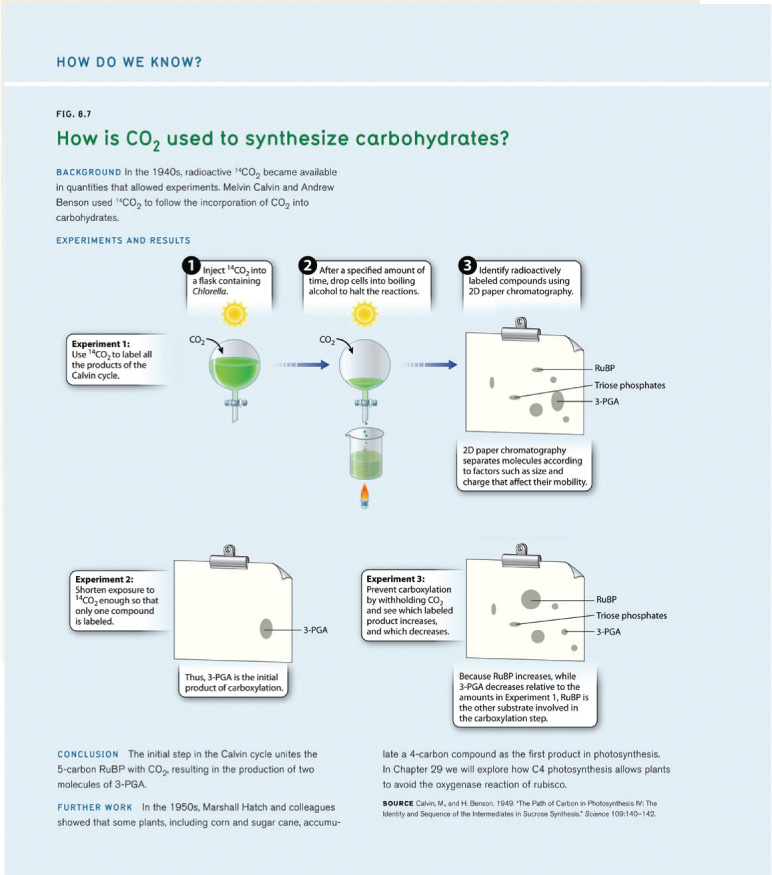
21
ACKNOWLEDGMENTS
A book like this one is a team effort, and we have had the good fortune of working with a remarkable, caring, and dedicated team. First and foremost, we would like to thank the thousands of students we have collectively taught. Their curiosity, intelligence, and enthusiasm have been sources of motivation for all of us. Our teachers and mentors have likewise provided us with models of patience, persistence, and inquisitiveness that we bring into our own teaching and research. They encourage us to be lifelong learners, teachers, and scholars.
We all feel very lucky to be a partner with W. H. Freeman and Company. From the start, they have embraced our project, giving us the space and room to carve out something unique, while at the same time providing guidance, support, and input from the broader community of instructors and students.
Susan Winslow, our publisher, deserves special thanks for her ability to expertly juggle all aspects of this first edition, keeping a watchful eye on important trends in education and science, carefully listening to what we wanted to do, and providing a gentle nudge from time to time.
This book represents a genuine, rewarding, and unique partnership with a team of assessment leaders and authors. We especially thank and acknowledge the contributions of lead assessment author Melissa Michael and assessment team leaders Mark Hens, John Merrill, Randall Phillis, and Debra Pires. We all learned a great deal about pedagogy and how to use questions as tools for teaching, not just testing.
We also especially thank Mark Hens of the University of North Carolina at Greensboro for his contribution to several chapters, and Kirsten Weir, an award-winning science writer and editor, who helped us to set the tone, write, and put together the case introductions.
Lead developmental editor Lisa Samols has just the right touch—she has the ability to listen as well as offer intelligent suggestions; she is serious with a touch of humor; she is quiet but persistent. Senior developmental editor Susan Moran has an eye for detail and the uncanny ability to read the manuscript like a student. Developmental editor Erica Pantages Frost brought intelligence and thoughtfulness to her edits.
Karen Misler kept us all on schedule in a clear and firm, but always understanding and compassionate, way. Thanks also to Dusty Friedman, who helped us start this project on schedule. Carolyn Deacy expertly managed the art program, keeping all the various components coordinated and offering intelligent advice, and Bill Page coordinated our initial relationship with Imagineering.
Shannon Howard, who focused on editorial research and development, and Lindsey Veautour, our market development manager, are remarkable for their energy and enthusiasm, and their creativity in ways to reach out to instructors and students.
We thank Robert Errera for coordinating the move from manuscript to the page. We also thank Diana Blume, our art director, and Tom Carling, the layout artist. Together, they managed the look and feel of the book, coming up with creative solutions for page layout.
Imagineering under the patient and intelligent guidance of Mark Mykytiuk provided creative, insightful art to complement, support, and reinforce the text. Christine Buese, our photo editor, and Jacquelin Wong and Deborah Anderson, our photo researchers, provided us with a steady stream of stunning photos, and never gave up on hard-to-find shots.
On the digital media front, we thank Amanda Dunning for her editorial insight into making pedagogically useful media tools, and Keri Fowler for managing and coordinating the media and websites. They both took on this project with dedication, persistence, enthusiasm, and attention to detail that we deeply appreciate.
We are very grateful to Debbie Clare for her work in marketing, Elaine Palucki for her insight into teaching and learning strategies, Donna Brodman for coordinating the many reviewers, and Yassamine Ebadat and Jane Taylor for their consistent and tireless support.
We are also extremely grateful for all of the hard work and expertise of the sales representatives, regional managers, and regional sales specialists. We have enjoyed meeting and working with this dedicated sales staff, who are the ones that ultimately put the book in the hands of instructors for the first time.
We would also like to acknowledge Charles Smith and Neil Patterson for their early support of the author team and helping to foster the idea that would eventually become How Life Works, and special thanks to Charles for many spectacular photos that appear throughout the book.
Countless reviewers made invaluable contributions to this book and deserve special thanks. From catching mistakes to suggesting new and innovative ways to organize the content, they provided substantial input to the book. They brought their collective years of teaching to the project, and their suggestions are tangible in every chapter.
And none of this would have been possible without the support, inspiration, and encouragement of our families.
22
Contributors
Thank you to all the instructors who worked in collaboration with the authors and assessment authors to write Biology: How Life Works assessments, activities, and exercises.
Allison Alvarado, University of California, Los Angeles
Peter Armbruster, Georgetown University
Zane Barlow-Coleman, formerly of University of Massachusetts Amherst
James Bottesch, Brevard Community College
Jessamina Blum, Yale University
Jere Boudell, Clayton State University
David Bos, Purdue University
Laura Ciaccia West, Yale University*
Laura DiCaprio, Ohio University
Tod Duncan, University of Colorado Denver
Cindy Giff en, University of Wisconsin Madison
Paul Greenwood, Colby College
Stanley Guff ey, University of Tennessee, Knoxville
Alison Hill, Duke University
Meg Horton, University of North Carolina at Greensboro
Kerry Kilburn, Old Dominion University
Jo Kurdziel, University of Michigan
David Lampe, Duquesne University
Brenda Leady, University of Toledo
Sara Marlatt, Yale University*
Kelly McLaughlin, Tufts University
Brad Mehrtens, University of Illinois at Urbana-Champaign
Nancy Morvillo, Florida Southern College
Jennifer Nauen, University of Delaware
Kavita Oommen, Georgia State University
Patricia Phelps, Austin Community College
Melissa Reedy, University of Illinois at Urbana-Champaign
Lindsay Rush, Yale University*
Sukanya Subramanian, Collin College
Michelle Withers, West Virginia University
*Graduate a student, Yale University Scientific Teaching Fellow
Reviewers, Class Testers, and Focus Group Participants
Thank you to all the instructors who reviewed and/or class tested chapters, art, assessment questions, and other Biology: How Life Works materials.
Thomas Abbott, University of Connecticut
Tamarah Adair, Baylor University
Sandra Adams, Montclair State University
Jonathon Akin, University of Connecticut
Eddie Alford, Arizona State University
Chris Allen, College of the Mainland
Sylvester Allred, Northern Arizona University
Shivanthi Anandan, Drexel University
Andrew Andres, University of Nevada, Las Vegas
Michael Angilletta, Arizona State University
Jonathan Armbruster, Auburn University
Jessica Armenta, Lone Star College System
Brian Ashburner, University of Toledo
Andrea Aspbury, Texas State University
Nevin Aspinwall, Saint Louis University
Felicitas Avendano, Grand View University
Yael Avissar, Rhode Island College
Ricardo Azpiroz, Richland College
Jessica Baack, Southwestern Illinois College
Charles Baer, University of Florida
Brian Bagatto, University of Akron
Alan L. Baker, University of New Hampshire
Ellen Baker, Santa Monica College
Mitchell Balish, Miami University
Teri Balser, University of Florida
Paul Bates, University of Minnesota, Duluth
Michel Baudry, University of Southern California
Jerome Baudry, University of Tennessee, Knoxville
Mike Beach, Southern Polytechnic State University
Andrew Beall, University of North Florida
Gregory Beaulieu, University of Victoria
John Bell, Brigham Young University
Michael Bell, Richland College
Rebecca Bellone, University of Tampa
Anne Bergey, Truman State University
Laura Bermingham, University of Vermont
Aimee Bernard, University of Colorado, Denver
Annalisa Berta, San Diego State University
Joydeep Bhattacharjee, University of Louisiana, Monroe
Arlene Billock, University of Louisiana, Lafayette
Daniel Blackburn, Trinity College
Mark Blackmore, Valdosta State University
Justin Blau, New York University
Andrew Blaustein, Oregon State University
Mary Bober, Santa Monica College
Robert Bohanan, University of Wisconsin, Madison
Jim Bonacum, University of Illinois at Springfield
Laurie Bonneau, Trinity College
David Bos, Purdue University
James Bottesch, Brevard Community College
Jere Boudell, Clayton State University
Nancy Boury, Iowa State University
Matthew Brewer, Georgia State University
Mirjana Brockett, Georgia Institute of Technology
Andrew Brower, Middle Tennessee State University
Heather Bruns, Ball State University
Jill Buettner, Richland College
23
Stephen Burnett, Clayton State University
Steve Bush, Coastal Carolina University
David Byres, Florida State College at Jacksonville
James Campanella, Montclair State University
Darlene Campbell, Cornell University
Jennifer Campbell, North Carolina State University
John Campbell, Northwest College
David Canning, Murray State University
Richard Cardullo, University of California, Riverside
Sara Carlson, University of Akron
Jeff Carmichael, University of North Dakota
Dale Casamatta, University of North Florida
Anne Casper, Eastern Michigan University
David Champlin, University of Southern Maine
Rebekah Chapman, Georgia State University
Samantha Chapman, Villanova University
Mark Chappell, University of California, Riverside
P. Bryant Chase, Florida State University
Young Cho, Eastern New Mexico University
Tim Christensen, East Carolina University
Steven Clark, University of Michigan
Ethan Clotfelter, Amherst College
Catharina Coenen, Allegheny College
Mary Colavito, Santa Monica College
Craig Coleman, Brigham Young University
Alex Collier, Armstrong Atlantic State University
Sharon Collinge, University of Colorado, Boulder
Jay Comeaux, McNeese State University
Reid Compton, University of Maryland
Ronald Cooper, University of California, Los Angeles
Victoria Corbin, University of Kansas
Asaph Cousins, Washington State University
Will Crampton, University of Central Florida
Kathryn Craven, Armstrong Atlantic State University
Scott Crousillac, Louisiana State University
Kelly Cude, College of the Canyons
Stanley Cunningham, Arizona State University
Karen Curto, University of Pittsburgh
Bruce Cushing, The University of Akron
Rebekka Darner, University of Florida
James Dawson, Pittsburg State University
Elizabeth De Stasio, Lawrence University
Jennifer Dechaine, Central Washington University
James Demastes, University of Northern Iowa
D. Michael Denbow, Virginia Polytechnic
Institute and State University Joseph
Dent, McGill University
Terry Derting, Murray State University
Jean DeSaix, University of North Carolina at Chapel Hill
Donald Deters, Bowling Green State University
Hudson DeYoe, The University of Texas, Pan American
Leif Deyrup, University of the Cumberlands
Laura DiCaprio, Ohio University
Jesse Dillon, California State University, Long Beach
Frank Dirrigl, The University of Texas, Pan American
Kevin Dixon, Florida State University
Elaine Dodge Lynch, Memorial University of Newfoundland
Hartmut Doebel, George Washington University
Jennifer Doll, Loyola University, Chicago
Logan Donaldson, York University
Blaise Dondji, Central Washington University
Christine Donmoyer, Allegheny College
James Dooley, Adelphi University
Jennifer Doudna, University of California, Berkeley
John DuBois, Middle Tennessee State University
Richard Duhrkopf, Baylor University
Kamal Dulai, University of California, Merced
Arthur Dunham, University of Pennsylvania
Mary Durant, Lone Star College System
Roland Dute, Auburn University
Andy Dyer, University of South Carolina, Aiken
William Edwards, Niagara University
John Elder, Valdosta State University
William Eldred, Boston University
David Eldridge, Baylor University
Inge Eley, Hudson Valley Community College
Lisa Elfring, University of Arizona
Richard Elinson, Duquesne University
Kurt Elliott, Northwest Vista College
Miles Engell, North Carolina State University
Susan Erster, Stony Brook University
Joseph Esdin, University of California, Los Angeles
Jean Everett, College of Charleston
Brent Ewers, University of Wyoming
Melanie Fierro, Florida State College at Jacksonville
Michael Fine, Virginia Commonwealth University
Jonathan Fingerut, St. Joseph’s University
Ryan Fisher, Salem State University
David Fitch, New York University
Paul Fitzgerald, Northern Virginia Community College
Jason Flores, University of North Carolina at Charlotte
Matthias Foellmer, Adelphi University
Barbara Frase, Bradley University
Caitlin Gabor, Texas State University
Michael Gaines, University of Miami
Jane Gallagher, The City College of New
York, The City University of New York
Kathryn Gardner, Boston University
J. Yvette Gardner, Clayton State University
Gillian Gass, Dalhousie University
Jason Gee, East Carolina University
Topher Gee, University of North Carolina at Charlotte
Vaughn Gehle, Southwest Minnesota State University
Tom Gehring, Central Michigan University
John Geiser, Western Michigan University
Alex Georgakilas, East Carolina University
Peter Germroth, Hillsborough Community College
Arundhati Ghosh, University of Pittsburgh
Carol Gibbons Kroeker, University of Calgary
Phil Gibson, University of Oklahoma
Cindee Giff en, University of Wisconsin, Madison
Matthew Gilg, University of North Florida
Sharon Gillies, University of the Fraser Valley
Leonard Ginsberg, Western Michigan University
Florence Gleason, University of Minnesota
Russ Goddard, Valdosta State University
Miriam Golbert, College of the Canyons
Jessica Goldstein, Barnard College, Columbia University
Steven Gorsich, Central Michigan University
Sandra Grebe, Lone Star College System
Robert Greene, Niagara University
Ann Grens, Indiana University, South Bend
Theresa Grove, Valdosta State University
Stan Guff ey, The University of Tennessee
Nancy Guild, University of Colorado, Boulder
Lonnie Guralnick, Roger Williams University
Laura Hake, Boston College
Kimberly Hammond, University of
California, Riverside
24
Paul Hapeman, University of Florida
Luke Harmon, University of Idaho
Sally Harmych, University of Toledo
Jacob Harney, University of Hartford
Sherry Harrel, Eastern Kentucky University
Dale Harrington, Caldwell Community College and Technical Institute
J. Scott Harrison, Georgia Southern University
Diane Hartman, Baylor University
Mary Haskins, Rockhurst University
Bernard Hauser, University of Florida
David Haymer, University of Hawaii
David Hearn, Towson University
Marshal Hedin, San Diego State University
Paul Heideman, College of William and Mary
Gary Heisermann, Salem State University
Brian Helmuth, University of South Carolina
Christopher Herlihy, Middle Tennessee State University
Albert Herrera, University of Southern California
Brad Hersh, Allegheny College
David Hicks, The University of Texas at Brownsville
Karen Hicks, Kenyon College
Alison Hill, Duke University
Kendra Hill, South Dakota State University
Jay Hodgson, Armstrong Atlantic State University
John Hoff man, Arcadia University
Jill Holliday, University of Florida
Sara Hoot, University of Wisconsin, Milwaukee
Margaret Horton, University of North Carolina at Greensboro
Lynne Houck, Oregon State University
Kelly Howe, University of New Mexico
William Huddleston, University of Calgary
Jodi Huggenvik, Southern Illinois University
Melissa Hughes, College of Charleston
Randy Hunt, Indiana University Southeast
Tony Huntley, Saddleback College
Brian Hyatt, Bethel College
Jeba Inbarasu, Metropolitan Community College
Colin Jackson, The University of Mississippi
Eric Jellen, Brigham Young University
Dianne Jennings, Virginia Commonwealth University
Scott Johnson, Wake Technical Community College
Mark Johnston, Dalhousie University
Susan Jorstad, University of Arizona
Stephen Juris, Central Michigan University
Julie Kang, University of Northern Iowa
Jonghoon Kang, Valdosta State University
George Karleskint, St. Louis Community College at Meramec
David Karowe, Western Michigan University
Judy Kaufman, Monroe Community College
Nancy Kaufmann, University of Pittsburgh
John Kauwe, Brigham Young University
Elena Keeling, California Polytechnic State University
Jill Keeney, Juniata College
Tamara Kelly, York University
Chris Kennedy, Simon Fraser University
Bretton Kent, University of Maryland
Jake Kerby, University of South Dakota
Jeff rey Kiggins, Monroe Community College
Scott Kight, Montclair State University
Stephen Kilpatrick, University of Pittsburgh, Johnstown
Kelly Kissane, University of Nevada, Reno
David Kittlesen, University of Virginia
Jennifer Kneafsey, Tulsa Community College
Jennifer Knight, University of Colorado, Boulder
Ross Koning, Eastern Connecticut State University
David Kooyman, Brigham Young University
Olga Kopp, Utah Valley University
Anna Koshy, Houston Community College
Todd Kostman, University of Wisconsin, Oshkosh
Peter Kourtev, Central Michigan University
William Kroll, Loyola University, Chicago
Dave Kubien, University of New Brunswick
Allen Kurta, Eastern Michigan University
Ellen Lamb, University of North Carolina at Greensboro
Troy Ladine, East Texas Baptist University
David Lampe, Duquesne University
Evan Lampert, Gainesville State College
James Langeland, Kalamazoo College
John Latto, University of California, Santa Barbara
Brenda Leady, University of Toledo
Jennifer Leavey, Georgia Institute of Technology
Hugh Lefcort, Gonzaga University
Brenda Leicht, University of Iowa
Craig Lending, The College at Brockport, The State University of New York
Nathan Lents, John Jay College of Criminal
Justice, The City University of New York
Michael Leonardo, Coe College
Army Lester, Kennesaw State University
Cynthia Littlejohn, University of Southern Mississippi
Zhiming Liu, Eastern New Mexico University
Jonathan Lochamy, Georgia Perimeter College
Suzanne Long, Monroe Community College
Julia Loreth, University of North Carolina at Greensboro
Jennifer Louten, Southern Polytechnic State University
Janet Loxterman, Idaho State University
Ford Lux, Metropolitan State College of Denver
Jose-Luis Machado, Swarthmore College
C. Smoot Major, University of South Alabama
Charles Mallery, University of Miami
Mark Maloney, Spelman College
Carroll Mann, Florida State College at Jacksonville
Carol Mapes, Kutztown University of Pennsylvania
Nilo Marin, Broward College
Diane Marshall, University of New Mexico
Heather Masonjones, University of Tampa
Scott Mateer, Armstrong Atlantic State University
Luciano Matzkin, The University of Alabama in Huntsville
Robert Maxwell, Georgia State University
Meghan May, Towson University
Douglas Meikle, Miami University
Michael McGinnis, Spelman College
Kathleen McGuire, San Diego State University
Maureen McHale, Truman State University
Shannon McQuaig, St. Petersburg College
Susan McRae, East Carolina University
Lori McRae, University of Tampa
Mark Meade, Jacksonville State University
Brad Mehrtens, University of Illinois at Urbana-Champaign
Michael Meighan, University of California, Berkeley
Richard Merritt, Houston Community College
Jennifer Metzler, Ball State University
James Mickle, North Carolina State University
Brian Miller, Middle Tennessee State University
Allison Miller, Saint Louis University
Yuko Miyamoto, Elon University
Ivona Mladenovic, Simon Fraser University
Marcie Moehnke, Baylor University
Chad Montgomery, Truman State University
Jennifer Mook, Gainesville State College
Daniel Moon, University of North Florida
25
Jamie Moon, University of North Florida
Jeanelle Morgan, Gainesville State College
David Morgan, University of West Georgia
Julie Morris, Armstrong Atlantic State University
Becky Morrow, Duquesne University
Mark Mort, University of Kansas
Nancy Morvillo, Florida Southern College
Anthony Moss, Auburn University
Mario Mota, University of Central Florida
Alexander Motten, Duke University
Tim Mulkey, Indiana State University
John Mull, Weber State University
Michael Muller, University of Illinois at Chicago
Beth Mullin, University of Tennessee, Knoxville
Paul Narguizian, California State University, Los Angeles
Jennifer Nauen, University of Delaware
Paul Nealen, Indiana University of Pennsylvania
Diana Nemergut, University of Colorado, Boulder
Kathryn Nette, Cuyamaca College
Jacalyn Newman, University of Pittsburgh
James Nienow, Valdosta State University
Alexey Nikitin, Grand Valley State University
Tanya Noel, York University
Fran Norfl us, Clayton State University
Celia Norman, Arapahoe Community College
Eric Norstrom, DePaul University
Jorge Obeso, Miami Dade College
Kavita Oommen, Georgia State University
David Oppenheimer, University of Florida
Joseph Orkwiszewski, Villanova University
Rebecca Orr, Collin College
Don Padgett, Bridgewater State College
Joanna Padolina, Virginia Commonwealth University
One Pagan, West Chester University
Kathleen Page, Bucknell University
Daniel Papaj, University of Arizona
Pamela Pape-Lindstrom, Everett Community College
Bruce Patterson, University of Arizona, Tucson
Shelley Penrod, Lone Star College System
Roger Persell, Hunter College, The City University of New York
John Peters, College of Charleston
Chris Petrie, Brevard Community College
Patricia Phelps, Austin Community College
Steven Phelps, The University of Texas at Austin
Kristin Picardo, St. John Fisher College
Aaron Pierce, Nicholls State University
Debra Pires, University of California, Los Angeles
Thomas Pitzer, Florida International University
Nicola Plowes, Arizona State University
Crima Pogge, City College of San Francisco
Darren Pollock, Eastern New Mexico University
Kenneth Pruitt, The University of Texas at Brownsville
Sonja Pyott, University of North Carolina at Wilmington
Rajinder Ranu, Colorado State University
Philip Rea, University of Pennsylvania
Amy Reber, Georgia State University
Ahnya Redman, West Virginia University
Melissa Reedy, University of Illinois at Urbana-Champaign
Brian Ring, Valdosta State University
David Rintoul, Kansas State University
Michael Rischbieter, Presbyterian College
Laurel Roberts, University of Pittsburgh
George Robinson, The University at Albany, The State University of New York
Peggy Rolfsen, Cincinnati State Technical and Community College
Mike Rosenzweig, Virginia Polytechnic
Institute and State University
Doug Rouse, University of Wisconsin, Madison
Yelena Rudayeva, Palm Beach State College
Ann Rushing, Baylor University
Shereen Sabet, La Sierra University
Rebecca Safran, University of Colorado
Peter Sakaris, Southern Polytechnic State University
Thomas Sasek, University of Louisiana, Monroe
Udo Savalli, Arizona State University
H. Jochen Schenk, California State University, Fullerton
Gregory Schmaltz, University of the Fraser Valley
Jean Schmidt, University of Pittsburgh
Andrew Schnabel, Indiana University, South Bend
Roxann Schroeder, Humboldt State University
David Schultz, University of Missouri, Columbia
Andrea Schwarzbach, The University of Texas at Brownsville
Erik Scully, Towson University
Robert Seagull, Hofstra University
Pramila Sen, Houston Community College
Alice Sessions, Austin Community College
Vijay Setaluri, University of Wisconsin
Jyotsna Sharma, The University of Texas at San Antonio
Elizabeth Sharpe-Aparicio, Blinn College
Patty Shields, University Of Maryland
Cara Shillington, Eastern Michigan University
James Shinkle, Trinity University
Rebecca Shipe, University of California, Los Angeles
Marcia Shofner, University of Maryland
Laurie Shornick, Saint Louis University
Jill Sible, Virginia Polytechnic Institute and State University
Allison Silveus, Tarrant County College
Kristin Simokat, University of Idaho
Sue Simon-Westendorf, Ohio University
Sedonia Sipes, Southern Illinois University, Carbondale
John Skillman, California State University, San Bernardino
Marek Sliwinski, University of Northern Iowa
Felisa Smith, University of New Mexico
John Sollinger, Southern Oregon University
Scott Solomon, Rice University
Morvarid Soltani-Bejnood, The University of Tennessee
Vladimir Spiegelman, University of Wisconsin, Madison
Chrissy Spencer, Georgia Institute of Technology
Kathryn Spilios, Boston University
Ashley Spring, Brevard Community College
Bruce Stallsmith, The University of Alabama in Huntsville
Jennifer Stanford, Drexel University
Barbara Stegenga, University of North
Carolina, Chapel Hill
Patricia Steinke, San Jacinto College, Central Campus
Asha Stephens, College of the Mainland
Robert Steven, University of Toledo
Eric Strauss, University of Wisconsin, La Crosse
Sukanya Subramanian, Collin College
Mark Sugalski, Southern Polytechnic State University
Brad Swanson, Central Michigan University
Ken Sweat, Arizona State University
David Tam, University of North Texas
Ignatius Tan, New York University
26
William Taylor, University of Toledo
Christine Terry, Lynchburg College
Sharon Thoma, University of Wisconsin, Madison
Pamela Thomas, University of Central Florida
Carol Thornber, University of Rhode Island
Patrick Thorpe, Grand Valley State University
Briana Timmerman, University of South Carolina
Chris Todd, University of Saskatchewan
Gail Tompkins, Wake Technical Community College
Martin Tracey, Florida International University
Randall Tracy, Worcester State University
James Traniello, Boston University
Bibit Traut, City College of San Francisco
Terry Trier, Grand Valley State University
Stephen Trumble, Baylor University
Jan Trybula, The State University of New York at Potsdam
Alexa Tullis, University of Puget Sound
Marsha Turell, Houston Community College
Mary Tyler, University of Maine
Marcel van Tuinen, University of North Carolina at Wilmington
Dirk Vanderklein, Montclair State University
Jorge Vasquez-Kool, Wake Technical Community College
William Velhagen, New York University
Dennis Venema, Trinity Western University
Laura Vogel, North Carolina State University
Jyoti Wagle, Houston Community College
Jeff Walker, University of Southern Maine
Gary Walker, Appalachian State University
Andrea Ward, Adelphi University
Fred Wasserman, Boston University
Elizabeth Waters, San Diego State University
Douglas Watson, The University of Alabama at Birmingham
Matthew Weand, Southern Polytechnic State University
Michael Weber, Carleton University
Cindy Wedig, The University of Texas, Pan American
Brad Wetherbee, University of Rhode Island
Debbie Wheeler, University of the Fraser Valley
Clay White, Lone Star College System
Lisa Whitenack, Allegheny College
Maggie Whitson, Northern Kentucky University
Stacey Wild East, Tennessee State University
Herbert Wildey, Arizona State University and Phoenix College
David Wilkes, Indiana University, South Bend
Lisa Williams, Northern Virginia Community College
Elizabeth Willott, University of Arizona
Mark Wilson, Humboldt State University
Ken Wilson, University of Saskatchewan
Bob Winning, Eastern Michigan University
Candace Winstead, California Polytechnic State University
Robert Wise, University of Wisconsin, Oshkosh
D. Reid Wiseman, College of Charleston
MaryJo Witz, Monroe Community College
David Wolfe, American River College
Kevin Woo, University of Central Florida
Denise Woodward, Penn State
Shawn Wright, Central New Mexico Community College
Grace Wyngaard, James Madison University
Aimee Wyrick, Pacifi c Union College
Joanna Wysocka-Diller, Auburn University
Ken Yasukawa, Beloit College
John Yoder, The University of Alabama
Kelly Young, California State University, Long Beach
James Yount, Brevard Community College
Min Zhong, Auburn University
27